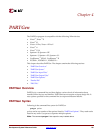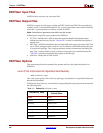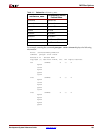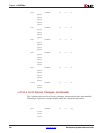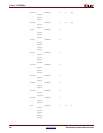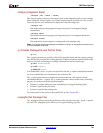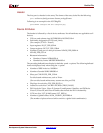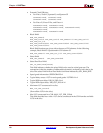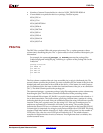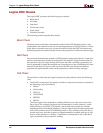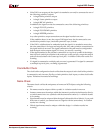
108 www.xilinx.com Development System Reference Guide
Chapter 4: PARTGen
R
–v (Creates Package and Partlist Files)
–v name
The –v option generates a partlist file in ASCII and XML format for the specified name and
also creates package files. Valid name entries include architectures, devices, parts.
Following are example command line entries of each type:
–v virtex
(Architecture)
–v xcv400 (Device)
–v v400bg432 (Part)
If no architecture, device, or part is specified with the –v option, information for every
installed device is submitted to the partlist.xct file.
The –v option generates more detailed information than the –p option. The –p and –v
options are mutually exclusive, that is, you can specify one or the other but not both. The -
p option generates a three column entry describing the pins. The -v option adds six more
columns of descriptive pin information.For each pin the following data appears:
• Column 1: contains either pin (user accessible pin) or pkgpin (dedicated pin).
• Column 2: specifies the pin name.
• Column 3: specifies the package pin.
• Column 4: IO_BANK is a positive integer associated with a VREF bank, or -1 to
indicate no VREF bank association.
• Column 5: IO_BANK is a positive integer associated with a VCCO bank, or -1 to
indicate no VCCO bank association.
• Column 6: specifies the function name, and consists of a string indicating how the pin
is used. If the pin is dedicated, then the string will indicate the specific function. If the
pin is a generic user pin, the string will be "IO." If the pin is multipurpose, an
underscore-separated set of characters will make up the string.
• Column 7: indicates the closest CLB row/column to the pin.
• Column 8: indicates LVDS IOB association, consisting of an index (ranging from 0 to
the number of LVDS pairs - 1) and the letter M or S. The value "N.A." indicates a non-
LVDS pin.
• Column 9: indicates the flight time data (trace length) in units of microns. If no data is
available, the column will contain zeros.
For a description of the entries in the partlist.xct file, see the “Partlist File” that follows.
Partlist File
The partlist file (XCT) contains detailed information about architectures and devices,
including supported synthesis tools. Optionally, the partlist file can be generated in XML
format with the
The partlist file is a series of part entries. There is one entry for every part supported in the
installed software. The following subsections describe the information contained in the
partlist.xct file.




